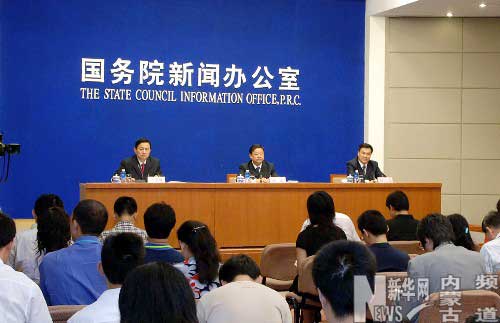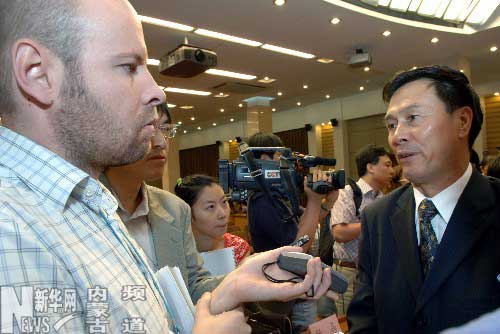| |
| Reuters |
| July 26, 2007 |
| Beijing |
 |
|
|
Inner
Mongolia Autonomous Region (IMAR) officials held a
press conference in Beijing to celebrate the 60th
anniversary of IMAR (Xinhua photo)
|
|
 |
|
|
IMAR
Governer Yang Jing answered questions by the Reuter
reporter on human rights issues of ethnic Mongolians
(Xinhua photo)
|
|
BEIJING, July 26 (Reuters) - The
60 years since China set up the Inner Mongolia Autonomous Region
have been marked by environmental destruction, persecution and
cultural assimilation and are not worth celebrating, an exiled
group said on Thursday.
Inner Mongolia -- called Southern Mongolia by some dissidents --
was China's first autonomous region at a provincial level and is
supposed to enjoy a high level of self government, much like
Tibet and Xinjiang in the far west.
Inner Mongolia's governor, Yang Jing, said this week that the
last 60 years had been ones of "ethnic unity and prosperity".
"For the Mongols, it is 60 years of human tragedy, environmental
destruction, social crisis and psychological trauma," said
Enghebatu Togochog, president of the New York-based Southern
Mongolian Human Rights Information Centre.
"The Chinese came in and got everything while the Mongols lost
everything including their basic human rights, fundamental
freedom, culture, tradition, lifestyle, and the natural habitat
where they maintained their distinct way of life for thousands
of years," he said in an emailed statement to Reuters.
"This celebration is not only a justification of China's
colonial occupation in Southern Mongolia but also (shows) the
determination of China's continuing suppression against the
Mongols," Togochog said.
Decades of migration by the dominant Han have made Chinese
Mongolians a minority in their own land, officially comprising
less than 20 percent of the almost 24 million population of the
Inner Mongolian Autonomous Region.
The government says it protects and promotes the rights and
culture of the Mongolians.
But Beijing, sensitive about ethnic unrest in strategic border
areas like Inner Mongolia and Tibet, keeps a tight rein on
minorities.
Less is known about human rights issues in Inner Mongolia, as
the Mongolians do not have well-known overseas advocates like
Tibet's Dalai Lama or Rebiya Kadeer, the Nobel Peace Prize
nominee called the "mother of the Uighur people". |





